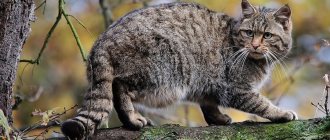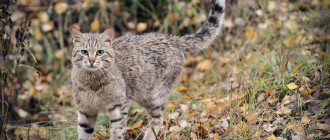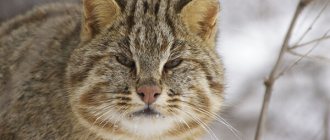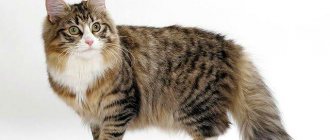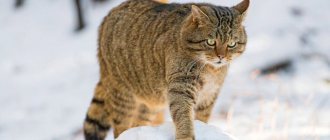The Amur forest cat (Prionailurus bengalensis euptilurus) belongs to the subspecies of the Bengal cat. It is considered a relative of the Amur tiger and the Far Eastern leopard. However, unlike its brothers, the Far Eastern cat was undeservedly deprived of attention.
Amur forest cat: description of the species
Cold indifference to this harmless animal has led to disappointing consequences - now the Amur cat is listed in the Red Book as an endangered subspecies. Thanks to the efforts of animal rights activists, in recent years the situation has leveled out - the population size is gradually increasing.
History of the species
Most likely, this species, a distant relative of the Bengal cat, lived in the Far East for a long time. But the first mentions and descriptions of the animal appeared only in 1871. These records are associated with the export of Amur forest cat skins to Chinese provinces.
Today, the Amur cat is classified as a genus of Oriental cats and a species of Bengal (described as a subspecies). The Latin name is Prionailurus bengalensis euptilurus.
Nutrition
The food of wild cats is very diverse.
The main diet is:
- field mice;
- shrews;
- muskrats;
- birds whose nests are located close to the surface of the earth;
- fish;
- snakes.
Wild cats do not form packs, but even one cat can afford to hunt animals of equal or larger weight:
- rabbits;
- martens;
- roe deer
Where does it live?
The habitat of the Far Eastern cat is quite wide. In Russia, it can be found on the coast of the Sea of Japan, in the lowlands of the Amur River and the adjacent taiga.
But it is also known in China, Japan, Korea, and the Malay Islands. Individuals are found very often near Lake Khanka - on the border of the Primorsky Territory and the border Chinese province of Heilongjiang. In addition, migrations of the Amur forest cat to the regions of Indonesia, Java, Sumatra, Burma and Nepal have been noted.
It is surprising that representatives of the species easily adapt to life in a tropical climate and in the conditions of the Ussuri taiga.
Amur forest cat: a home for a hermit
The homeland of the Amur cat, as is clear from its name, is the Far East. On the territory of our country, the animal is found in the Amur River basin and on the coast of the Sea of Japan. Far Eastern cats also live in Japan (where it is called the Tsushima leopard cat), China, and the Korean Peninsula.
The individual territory of each individual can reach 10 square kilometers. For life, this small predator, despite its “unsociable” character, does not choose an impenetrable dense forest. Its favorite habitats are forest edges, copses, clearings and paddocks, thickets of bushes and reeds along the banks of reservoirs, and meadows overgrown with tall grass.
The predator prefers not to climb high into the mountains - it is believed that it is not in its rules to “conquer” peaks more than half a kilometer in height. In winter, the Far Eastern cat generally prefers river and lake valleys to mountains.
Usually, on the territory of each animal there are several “apartments” that the cat uses - these can be crevices in stones or tree hollows. The tailed one does not disdain abandoned burrows of other predators - for example, badgers and foxes. For comfort, he lines the floor of his home with wood dust, fallen leaves and dry grass.
Mr. Cat recommends: appearance features
The Amur cat is a small predatory mammal of the feline order, slightly larger than an ordinary domestic cat. The average weight of an individual is about 7 kg, although the largest representatives of the species reach 15.
A cat's weight fluctuates significantly and depends on the time of year, especially in cold climates. By the end of winter, the individual is usually extremely thin; by the beginning of autumn, after the end of the hunting season, it has significant reserves of subcutaneous fat.
The maximum body length is 90 cm, the tail is quite short - about 40 cm, height at the withers is about 40 cm.
But the size of the Amur forest cat varies significantly depending on its habitat and natural climatic conditions in its habitat.
The predator has a small elongated head with deep and fairly close-set large almond-shaped eyes. The ears are medium in size, set wide and oblique, slightly tilted forward. Their tips are rounded and there are no tassels on them. On the back surface of the auricle there are “false” eyes, like all wild cat species. It is along these white markings that the brood follows the mother in the dark.
The nose is large and wide with a protruding nose from pink to brick-brown. The cheeks are well developed, hiding powerful jaws with fairly long and strong teeth.
The preview of this video is Pallas's cat! But the video is really about the Far Eastern cat.
By the way, here is this handsome guy in the photo:
The paws of the Far Eastern cat are of medium length, strong and muscular, with pads with edging between the toes and short, but very strong and sharp claws that are easily retracted.
The skin of the Far Eastern cat has very long fur - about 5 cm. Its color can range from dirty yellow to dark brown. It also changes depending on the season of the year - in winter it gets lighter (and the undercoat thickens), in summer it gets darker. Molting usually occurs twice a year - in the off-season.
The color of the Far Eastern cat was formed for better camouflage in its habitats and for the most part protects the animal well in the Ussuri taiga.
The main color of the coat is much lighter than the dark stripes on the head, back, paws and tail, which always has a black tip.
The chin and belly are usually white. There are clear spots on the abdomen, which are always characteristic of the tabby color. On the neck and chest there is usually a “necklace” of several, up to five, red rings. There are also spots among the stripes on the sides and back. Their number depends on age - the younger the predator, the fewer there are.
Due to the rather long undercoat, the spots do not have clear boundaries. That is why in China they are called “cash”, and in shape they resemble the coins of this country.
The fur pattern of young individuals is bright, leopard-print; with age it becomes more faded and inconspicuous.
Animal color
Among its breed, the Far Eastern wild cat is distinguished by thick and long hair. The body hair of an adult cat can reach 5 cm in length. This color allows it to live in difficult climatic conditions. In the fall, the cat sheds, its fur becomes thicker and longer, and in the spring it sheds again.
The red-brown color makes the cat almost invisible among the trees. The back of the animal is darker than the belly, the color varies from grayish-yellow to grayish-brown. A cat has 3 dark brown stripes along its spine, which in some animals merge into one wide stripe. There are 4-5 transverse thin stripes of a reddish tint on the neck. Stripes also decorate the cat's mouth and paws.
The long, thin tail is usually a solid red or brown color. But in some specimens it has gray or black stripes.
Habits and Habits
Although the Amur forest cat has many enemies, in its natural environment it usually lives for a very long time, up to 18 years. This animal is very careful and leads a leisurely lifestyle. Especially in taiga winter conditions, the rhythm of this predator seems to freeze. Everything is aimed at survival until the bright Far Eastern spring - metabolism slows down, blood pressure decreases.
Like most cat species, Amur forest cats are loners. The habitat of each individual is about 10 square meters. km. Animals carefully guard their territory and protect it from attacks by their fellow creatures; they do not leave it even if there is a formidable rival there - a tiger. For overnight stays, several rookeries are set up in snow-covered windfalls, abandoned burrows, and rock crevices.
In hunting, the tactics of waiting and tracking are preferred to open attack. Usually, every throw of the Amur Forest Cat is accurate and deadly.
The mating season begins in the spring, at which time pairs are formed and remain together for a long time, until the cubs become independent.
The only sounds that can be heard from these predators are the trumpet roar, which is how they call the female. In other cases, the animals are silent, even in the face of imminent danger they only hiss. Far Eastern cats have many enemies - in addition to tigers, they also include lynxes, wolves, eagle owls, owls, golden eagles, sables, wolverines, martens, and ferrets.
Predators usually do not approach human settlements, but during the rut or a particularly cold winter, this can happen.
Despite its small size, the Far Eastern cat is a dangerous shadow hunter, but it is never the first to attack a person unless it is protecting the cubs and the nest. The predator waits for its prey after sunset or in the predawn twilight.
It feeds most often on rodents, birds and small mammals. Large specimens hunt hares and medium-sized roe deer. They do not disdain snakes, badgers, and partridges, which they take great pleasure in digging out from under the snow in winter.
In summer, Amur cats eat a lot - up to 20 mice or birds per day, often hiding uneaten prey near their homes. This is due to the need to accumulate fat for the winter - a period of rare and passive hunting.
Mating usually occurs in March-April. The pair then builds a nest in a large hollow tree or under its roots. Pregnancy in a female proceeds normally - from 65 to 73 days. There are usually few kittens in a litter, from one to four.
Babies first emerge from the nest at the age of about two months. All this time, the father and mother take care of the kittens and get food for them. Then the children begin to learn the skills of hunting and independent living. By six months, the young animals leave their mother, and the couple also separates until the next rut.
Females become sexually mature by 10-12 months, males by 1.5 years.
How does it reproduce?
The Far Eastern cat is accustomed to leading a solitary lifestyle. However, with the onset of autumn, he begins to look for the female, calling her with a abrupt and loud growl. The duration of pregnancy is no more than 70 days. At the end of spring, the female brings offspring. The Ussuri kitten is born blind, its weight does not exceed 100 g. Its eyes open 2 weeks after birth. After 2 months, the kittens leave the nest and explore the territory under the supervision of the female. The father of the family also raises the offspring. After six months, the kittens leave the nest and find their own territory where they will live and hunt. Far Eastern cats reach adulthood after 1 year of life. Its duration is on average 10-12 years.
Number
The name of this animal is in the Red Book.
Far Eastern cats are incredibly secretive and cautious, so scientists have not yet been able to carry out even an approximate count of them. Despite this, not so long ago the animals were listed in the Red Book. Some are convinced that this is connected with hunting cats, but this opinion is not true. The species is in danger of extinction, as there are fewer and fewer areas suitable for their existence. In addition, burning of last year’s leaves, which is carried out every year, also poses a danger to these predators.
The Far Eastern cat is not dangerous to humans. Despite this, in the USSR it was classified as a lynx and a wolf, which could harm people. In this regard, the Amur cat was often killed for no reason in order to receive a monetary reward from the village council. Hunting for the animal was not carried out in Russia, since its fur is not of particular value. However, in the People's Republic of China it was hunted for its fur. Nowadays, killing these cats is punishable by law.
Captivity
Representatives of this feline species are represented in many zoos around the world.
Predators adapt well to any conditions and reproduce well, caring for their offspring with tenderness. But they treat the person with caution and make no attempts to “make friends,” unlike, for example, the balanced and friendly Caracal.
Even in cases where the indigenous inhabitants of the Far East picked up kittens found next to their dead mother, and they were raised by a domestic cat, attempts to tame the cubs led nowhere. With the onset of puberty, the animals showed a wild disposition and had to be released or transplanted into an enclosure.
It is not safe to keep such animals in the house. But there is the possibility of partial domestication of individuals with early castration.
At the beginning of this century, an attempt was made to hybridize the Amur forest cat. The male behaved very aggressively, but the mating took place and the offspring were born. Felinologists are not sure of the need to develop a new breed based on this variety, and the purity of the species of a unique animal may suffer.
But scientists of the Siberian Branch of the Russian Academy of Sciences, on the contrary, see hybridization as the salvation for the survival of this unique species, which is disappearing from the face of the planet just before our eyes. At the same time, due to difficult natural interspecific matings, experts suggest using in vitro fertilization.
Description. Breed standard
The photo of forest cats presents us with an animal similar to ordinary gray domestic pets.
However, they have a larger body, reaching 4–8 kg. Under natural conditions, their weight depends on the season, availability of prey and age. An old cat in winter will weigh several times less than a well-fed young cat in the warm season. Weight ranges from 2.5–5.9 kg for females and from 3.5–8 kg for males. Moreover, a wild forest cat is inferior in size and weight to individuals living in captivity, especially if they have been castrated or sterilized. The body dimensions of this cat breed are as follows:
- females are approximately 75–80 cm long and 40 cm high at the withers;
- males reach a length of 90 cm and a height of up to 43 cm.
The forest cat lives quite a long time, up to 15 years in the natural environment and up to 30 years at home, in captivity. This period exceeds the life expectancy of ordinary cats.
In appearance, at first glance, a wild European cat is difficult to distinguish from a domestic one. Taking a closer look, discrepancies become noticeable. So, a forest dweller’s tail has a blunt end, it is shorter than that of a domestic cat, and fluffier. The shedding of a wild animal is more noticeable: in winter its fur is uniform, thick, fluffy and shiny. Shedding occurs in spring until May, in autumn until November. The track of a forest cat is identical to that of a domestic cat, but is slightly larger. The hind paws have four toes, the front paws have five. Sharp claws retract.
The forest cat has medium-sized, wide-set ears. The ears do not have tassels and can rotate to identify the direction of sound. The vision is stereoscopic, there are no eyelashes. Yellow-green eyes have a third eyelid - a nictitating membrane that performs a protective function. Forest animals have well-developed vision and hearing, while their sense of smell is slightly weaker. The teeth are sharp and small.
A wild cat makes sounds and screams similar to the screams of domestic pets, usually during mating periods; the rest of the time it is silent. But at the moment of aggression or attack, she can hiss, howl and whistle. The main enemies of forest cats are lynx, fox, marten, jungle cat, wolf and jackal, hawk and owl.
For habitat, the forest cat prefers:
- mixed and broad-leaved forests (chooses remote areas, climbs trees well);
- rocky and rocky areas of mountains (rises to heights of 3000 m above sea level);
- near rivers it settles in reed thickets.
In nature, the predatory forest cat feeds on small animals (hares, shrews, rabbits and moles), rodents (rats, nutria, mice, muskrats, voles), fish, lizards and snakes. He will not refuse plant food - leaves of some plants. Does not disdain mollusks, insects and crayfish. It can easily cope with ermine, weasel, marten and ferret. Of the larger animals, it attacks roe deer or chamois calves left without parental care.
Species protection
Long years of extermination of the Far Eastern cat both in Russia and China led to almost complete extinction of the species.
Now the Amur forest cat is listed in the International Red Book as an endangered species. The population has only recently begun to grow slightly, although there is no exact data on how many of these animals there are in the world. Approximately - no more than three thousand heads. In 2004, a commemorative coin with the image of this predator was issued in Russia.
In Japan, in nature reserves and zoos, there are only about a hundred animals. There is a representative of this species in the menageries of China and Russia.
Numerous reserves are located in the Primorsky Territory of Russia - Land of the Leopard, Kedrovaya Pad, Khankaisky, Ussuriysky, Lazovsky. In the Khabarovsk Territory - Bolshekhekhiretsky.
A significant role in the almost complete disappearance of a unique cat species is played by human activity - cutting down and burning forests, plowing up virgin lands, targeted (during Soviet times) or accidental extermination. The fact is that, due to its small size, the Far Eastern cat quite often falls into traps set for hares.
The fine, even for accidentally killing an Amur forest cat, is significant. In addition, residents of areas in the habitats of the species are constantly informed about the benefits of this animal in the fight against rodents.
1111
Habitats
The habitats of the Far Eastern forest cat are:
- Amur River basin;
- coast of the Sea of Japan;
- China.
For life, the Amur cat prefers dense forests on the slopes of mountains, as well as thickets of bushes in secluded areas rarely visited by people. By nature, animals are very cautious and therefore strive with all their might to avoid contact with humans. Because of this, the Far Eastern cat immediately tries to leave if any active work begins in its habitat. He moves to a calmer and quieter place, where human contact is extremely rare.
shutterstock
Life with a man
But, despite the fact that keeping Amur cats at home and buying and selling transactions are prohibited, and failure to comply with this ban is subject to a fine of up to a million rubles. This does not stop some, and exotic lovers strive to acquire an unusual predatory cat, challenging their wild nature. From time to time there are advertisements for the sale of such cats, the price for them reaches one hundred thousand rubles, but keeping such a pet will cost even more.
In such cases, it is necessary to remember that his predatory nature will not go away and will not become an affectionate kitten, and sometimes this can even become dangerous.
If you still manage to get such a cat at home, you need to follow some recommendations.
- Create a free enclosure for the cat, with equipment for jumping and climbing.
- Feed your pet once a day, preferably at the same time.
- The diet should include poultry, lean beef, veal and rabbit, and don’t forget about mice.
- Sometimes you can give your pet fish, boiled vegetables and eggs.
- Once a week, do a fasting day for the cat.
- Provide the cat with toys: balls, mice.
It has been proven that even if you take a newly born kitten and try to tame it, nothing will work, the hunting instincts will make themselves felt, and the animal will want to go into the wild. Even after a long stay in captivity, the cat will be able to easily adapt to the forest and will not disappear.
The Amur forest cat is a unique subspecies of the cat family. Nature has rewarded it with an unusual coloring, tenacious paws, a strong body and a death grip. Listing in the Red Book protects the cats’ habitat and species. Despite warnings and fines, they still try to domesticate wild cats, sometimes without creating the necessary living conditions and putting themselves in danger.
Feeding in captivity
The main food of the Far Eastern forest cat in captivity is lean meats, such as beef, but without live food - rats, mice, day-old chicks and quails, it is difficult to maintain normal physiological activity and reproduction of animals, especially since the behavioral characteristics of the predator are dulled, which leads to " obsessive movements”, boredom of the animal. In addition, the animal eats not only fresh meat, but also the contents of the intestines, the brain, and part of the skin with wool (feather) of “live” food. It is believed that to complete protein metabolism, it is advisable to offer fish once a week. But not all the time. Excess fish in the diet can lead to the leaching of calcium from the animal’s body and, accordingly, to associated diseases, such as rickets.
For daily feeding of a Far Eastern forest cat, 2 mice, or one rat and about 200 grams are enough. lean meat. Feed once a day.
An equally important component of feeding is a weekly fasting or “fasting” day, when the animal (except for females during lactation and kittens up to six months of age) is not given meat or live food. However, some experts, once a week, in addition to the “hungry” day, arrange a “half-starved” day, when the norm of meat or live food is given at half the norm
This is important, since in captivity cats do not expend energy as intensively as in the wild and therefore often become fat, get sick and even die.
When keeping cats indoors, in good weather it is necessary to periodically walk them outdoors. On the street, the cat receives natural ultraviolet light (which is extremely necessary for the production of vitamin D, which in turn has a positive effect on health), feeds on meadow grass (looking for the necessary herbs for the body), and gets acquainted with new smells. Walking “domestic” cats is important for the full physical and psycho-emotional development of the animal.
Life expectancy in captivity is 20 years.
Population status
Currently, the Amur forest cat is included in the Red Book. The exact number of cats of this subspecies is unknown today. According to rough estimates, it does not exceed two and a half to three thousand individuals.
According to the generally accepted point of view, the number of Amur cats has decreased by at least a third. Part of the responsibility for the sharp decline in wild cats lies with humans themselves, as they are involved in:
- plowing virgin soil;
- cutting down bushes;
- setting fire to stakes (small forests in the fields).
Many representatives of the subspecies fell into hunting traps and snares, originally intended for hares. Uncontrolled natural fires also played a destructive role.
All the negative factors described above led to the fact that in 2015 there were only a few thousand Amur forest cats.
Prevention of extermination
Thanks to the efforts of animal rights activists, a significant fine was introduced for the destruction of Amur cats, reaching several thousand rubles. In the near future, it is planned to systematically inform local residents, especially hunters, about rare representatives of the local fauna, as well as about the usefulness of wild cats in the fight against rodents. Also, Far Eastern cats are under vigilant supervision in Japan, where about fifty representatives of the subspecies live.
Reserves
It is difficult to overestimate the contribution of protected areas in the regions, which provide greater safety for animals. The list of such territories includes
- Land of the Leopard National Park;
- Kedrovaya Pad Nature Reserve;
- Bolshekhehtsirsky Nature Reserve;
- Lazovsky Reserve;
- Khanka Nature Reserve;
- Ussuri Nature Reserve.
Zoos
The Far Eastern leopard cat is a rare guest in zoos. It is mainly kept in zoos in China and Japan, but in Russia there are several places where this animal lives, for example, the Barnaul Zoo.
They say that Amur cats do not live in zoos, but simply die for a long time
There are several reasons for such a low prevalence of the Amur cat. Firstly, catching a wild cat specifically for collection is not an easy task. That is why the Amur cat was and remains one of the most poorly studied subspecies.
Secondly, leopard cats languish in captivity. Even in a zoo, where no one and nothing threatens the cat, the wild animal remains wild and extremely cautious. As a rule, he builds a hole for himself or uses an already prepared one, only occasionally coming into contact with people and other inhabitants.
When surrounded by people and other animals, cats remain withdrawn and cautious.
Despite the unadaptability of wild cats to life in a cage, in zoos and enclosures the life expectancy of representatives of the subspecies is 17-18 years, while in the wild they are given 10-12 years. However, there are a variety of assumptions about the number of years allotted to a forest cat by nature. Some argue that 18 years is not the limit.
Bengal cat
In Western countries, Bengal cats are called leopard cats, so sometimes there can be confusion as there is a special type of domestic cat, also called Bengal. Wild representatives of this breed of cats live in the southern and eastern regions of Asia. The Bengal cat population of the Indonesian islands of Sumatra and Borneo has recently been developed into a separate species called the Zunda Bengal cat.
With a body length of 65 centimeters, this cat ranks third among the smallest wild animals in Asia. Bengal cats are excellent at climbing trees, hunting their inhabitants, insects and small rodents. The population of this species is considered quite stable, so it is listed as Least Endangered on the IUCN Red List.
Most national parks on the island of Borneo in Indonesia boast the presence of a Bengal cat, which thrives in the wild, but under the supervision of animal control.
8
